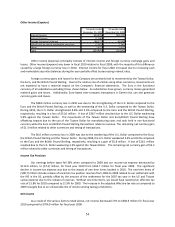Garmin 2010 Annual Report Download - page 54
Download and view the complete annual report
Please find page 54 of the 2010 Garmin annual report below. You can navigate through the pages in the report by either clicking on the pages listed below, or by using the keyword search tool below to find specific information within the annual report.44
Lifetie™ poduts ae defeed at the tie of sale ad eogized atal o a staight-line basis over the
currently estimated 36-month life of the products.
For multiple-element arrangements that include tangible products that contain software essential to the
tagile poduts futioalit ad udelieed softae eleets that elate to the tagile poduts essetial
software, the Company allocates revenue to all deliverables based on their relative selling prices. In such
circumstances, the accounting principles establish a hierarchy to determine the selling price to be used for
allocating revenue to deliverables as follows: (i) vendor-specific objective evidence of fair value VSOE, ii third-
pat eidee of sellig pie TPE, ad iii est estiate of the sellig pie ESP. VSOE generally exists only
when the Company sells the deliverable separately and is the price actually charged by the Company for that
deliverable. In addition to the products listed below, the Company has offered certain other products that involve
multiple-element arrangements that are immaterial.
In 2010, Garmin began offering PNDs with lifetime map updates (LMU) bundled in the original purchase
pie. Siila to üMaps Lifetie™ hih as itodued i Jaua , this eales ustoes to doload
the latest map and point of interest information every quarter for the useful life of their PND. The Company has
identified two deliverables contained in arrangements involving the sale of PNDs including LMU. The first
deliverable is the hardware and software essential to the functionality of the hardware device delivered at the
time of sale, and the second deliverable is the LMU. The Company has allocated revenue between these two
deliverables using the relative selling price method determined primarily using VSOE. Amounts allocated to the
delivered hardware and the related essential software are recognized at the time of sale provided the other
conditions for revenue recognition have been met. Amounts allocated to the LMU are deferred and recognized on
a straight-line basis over the estimated 36-month life of the products.
In addition, Garmin offers PNDs with premium traffic bundled in the original purchase price in the
European market. The Company has identified two deliverables contained in arrangements involving the sale of
PNDs including premium traffic. The first deliverable is the hardware and software essential to the functionality of
the hardware device delivered at the time of sale, and the second deliverable is the premium traffic service. The
Company has allocated revenue between these two deliverables using the relative selling price method
determined using VSOE. Amounts allocated to the delivered hardware and the related essential software are
recognized at the time of sale provided the other conditions for revenue recognition have been met. Amounts
allocated to the premium traffic service are deferred and recognized on a straight-line basis over the estimated 36-
month life of the products.
In 2009, Garmin introduced the nüvi 1690, a premium PND with a built‐in wireless module that lets
ustoes aess Gais üLik!™ seie, hih poides diet liks to etai oline information. The
Company has identified two deliverables contained in arrangements involving the sale of the nüvi 1690. The first
deliverable is the hardware and software essential to the functionality of the hardware device delivered at the
time of sale, and the second deliverable is the nüLink service. The Company has allocated revenue between these
two deliverables using the relative selling price method determined using VSOE. Amounts allocated to the
delivered hardware and the related essential software are recognized at the time of sale provided the other
conditions for revenue recognition have been met. Amounts allocated to the nüLink services are deferred and
recognized on a straight-line basis over the 24-month life of the service.
Garmin records estimated reductions to revenue for customer sales programs returns and incentive
offerings including rebates, price protection (product discounts offered to retailers to assist in clearing older
products from their inventories in advance of new product releases), promotions and other volume-based
incentives. The reductions to revenue are based on estimates and judgments using historical experience and
epetatio of futue oditios. Chages i these estiates ould egatiel affet Gais operating results.
These incentives are reviewed periodically and, with the exceptions of price protection and certain other
promotions, are accrued for on a percentage of sales basis. If market conditions were to decline, Garmin may take
actions to increase customer incentive offerings possibly resulting in an incremental reduction of revenue at the
time the incentive is offered.
























